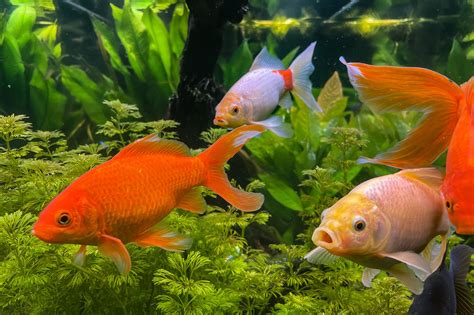The Ultimate Guide to Goldfish and Aquariums: Everything You Need to Know
Introduction
Goldfish are captivating and colorful fish that have captivated hobbyists for centuries. Whether you're a seasoned aquarist or a novice looking to embark on your first aquatic adventure, this comprehensive guide will provide you with everything you need to know about goldfish care and aquarium setup.
Transition: Understanding Goldfish and Their Origin
Goldfish Species and Varieties
Fancy Goldfish: These goldfish are bred for their unique and elaborate fins, tails, and body shapes. Some popular fancy goldfish varieties include:
-
Oranda: A large goldfish with a distinctive hump on its head.
-
Ryukin: A short-bodied goldfish with a high back and flowing tail.
-
Veiltail: A goldfish with flowing fins and a long, trailing tail.
Common Goldfish: Also known as "feeder goldfish," these goldfish are not specifically bred for aesthetic purposes. They are typically smaller and have a more streamlined body shape.
Transition: Setting Up a Goldfish Aquarium
Aquarium Size and Filtration
The size of your aquarium will depend on the number and size of goldfish you plan to keep. A good rule of thumb is to provide at least 20 gallons of water per goldfish.

An efficient filtration system is crucial for maintaining water quality. Consider a filter with a flow rate of at least 4-5 times the aquarium's volume per hour.

Transition: Water Parameters and Maintenance
Water Chemistry for Goldfish
Goldfish thrive in water with the following parameters:

-
Temperature: 65-75°F
-
pH: 7.0-8.0
-
Ammonia: 0 ppm
-
Nitrite: 0 ppm
-
Nitrate: Less than 20 ppm
Regular water changes are essential for keeping water parameters stable. Aim to change 25-50% of the water every 2-3 weeks.
Transition: Substrate and Plants
Substrate and Aquarium Decor
| Substrate Type | Benefits and Drawbacks | Recommendations |
|---|---|---|
| Gravel | Durable and easy to clean; can trap waste | Rounded gravel to prevent injuries |
| Sand | Natural and aesthetically pleasing; requires frequent cleaning | Fine sand to avoid compaction |
| Bare Bottom | Easy to clean; allows for better circulation | Use with a powerful filter |
Plants: Live plants provide hiding places, oxygenation, and natural filtration. Consider plants like:
- Java fern
- Anubias
- Water sprite
Transition: Goldfish Diet and Feeding
Nutritious Goldfish Food
Goldfish are omnivorous and require a balanced diet that includes:
-
Flakes or pellets: High-quality commercial fish food formulated for goldfish.
-
Live food: Bloodworms, brine shrimp, and tubifex worms (offer sparingly).
-
Vegetables: Blanched spinach, peas, and carrots (remove peels and seeds).
Feed goldfish 2-3 times daily, offering as much as they can consume in a few minutes. Avoid overfeeding.
Transition: Goldfish Health and Common Diseases
Maintaining Healthy Goldfish
Signs of a Healthy Goldfish:
- Active and alert
- Clear eyes and gills
- Smooth scales
- No visible parasites or injuries
Common Goldfish Diseases:
-
Ich: A parasitic infection causing white spots on the body.
-
Fin rot: A bacterial infection causing disintegrating fins.
-
Dropsy: A condition causing fluid retention and bloating.
Seek veterinary assistance promptly if you suspect any health issues.

Transition: Tips and Tricks for Goldfish Care
Enhance Goldfish Well-being
-
Quarantine New Fish: Isolate new goldfish for several weeks before introducing them to the main aquarium.
-
Monitor Water Quality: Regularly test water parameters and adjust as needed.
-
Provide Hiding Places: Ample hiding places reduce stress and promote well-being.
-
Minimize Overcrowding: Avoid overcrowding the aquarium to prevent water quality issues and aggression.
-
Use Live Plants: Live plants offer natural food sources, oxygenation, and water filtration.
Transition: Troubleshooting and FAQs
Common Goldfish Care Questions
Q: How often should I clean my goldfish tank?
A: Perform partial water changes of 25-50% every 2-3 weeks. Clean the gravel or substrate regularly as well.
Q: What are the signs of goldfish aggression?
A: Fin nipping, chasing, and territorial behavior are common signs of aggression.
Q: Can I mix goldfish with other fish species?
A: Goldfish can be compatible with some peaceful species, such as white cloud mountain minnows and zebra danios. However, avoid aggressive fish like cichlids.
Q: How long can goldfish live?
A: With proper care, goldfish can live for 10-15 years.
Q: What is the best temperature for goldfish?
A: Goldfish thrive in water temperatures between 65-75°F.
Q: Can goldfish eat bread?
A: Bread is not a suitable food for goldfish and can lead to health problems.
Transition: Conclusion
Your Guide to Thriving Goldfish
With the knowledge and tips provided in this guide, you can create a thriving environment for your goldfish to flourish. Remember to monitor water quality, provide a balanced diet, offer plenty of hiding places, and address health issues promptly. By following these guidelines, your goldfish will bring you years of joy and beauty.
Call to Action
Embark on your goldfish journey today. Visit your local pet store or breeder to select the perfect goldfish for your aquarium. Provide them with the best possible care and witness the wonders of these captivating creatures firsthand.
